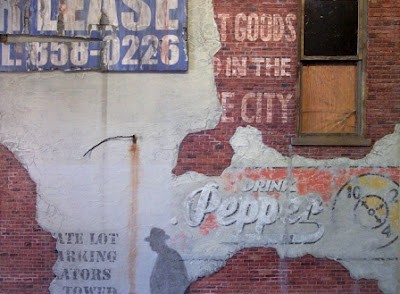9 Mar 2008
Its All Art
‘Goods in the City’ by Keith J. Hampton
Keith Hampton over at It’s All Art kindly sent me this example of some work he has produced inspired by the ghost signs found in Indianapolis, USA.
When I first saw this one (there’s another called ‘Miami Alley’) I assumed it was a collage, either digital or based on printed photographic materials. However, it turns out that the process is far more elaborate and actually involved the construction and fabrication of the wall, window and signs from raw materials. Keith has also produced a photo diary of this process so you can see what a large scale production it is, taking over six weeks from start to finish.
It seems that there are many ways that people relate to and interpret Ghost Signs. People like Frank Jump, Lawrence O’Toole and I simply photograph what we see as a dissappearing phenomena. It becomes a documentary process as we become conscious of the fact that their fading is itself a sign that they will one day be gone forever. Alongside this is the desire to understand more about not only the specific companies advertised but the people that once produced them. They provide one window through which the past can be observed and considered.
Where these approaches are distinctly backward looking, the work of Colossal Media uses these historical artefacts as inspiration for developing new modern brickads. Although these are ultimately commercially driven there is no escaping the art and craftsmanship that go into their productions. In this way painted signs, as a collective, gain new life. There are also tributes, parodies and spoofs such as Jack Daniels very recently, Watneys much longer ago and some of the work of former ‘wall dog’ Jerry Johnson.
Then we have artists like Martin Thompson who takes photographs of signs and uses paint and perspective adjustments to alter their reality. Not only are the signs themselves brought vividly to the fore but the surrounds are often dramatised in terms of the weather and built environment. Keith Hampton here offers another artistic interpretation by physically reconstructing the signs themselves and their environment. He describes his interpretation as relating to more than just the signs but also their environments (physical and in time) and the ways that people relate to them:
“In the last four years, my focus on language and it’s corollary symbology has evolved into visualizations of our own relative recent history.
Ghost Walls (also known as Ghost Signs) the term used for painted advertising and other forms of recent palimpsests are seen yet mostly ignored in every city throughout the world. I have been striving to capture the ambiguity of these layered messages with my recent paintings and constructions. In some cases the work is accomplished in paint only but in others it is achieved by constructing actual scaled-down walls that are my own versions of palimpsests. Many of these are researched through books and actual site observation. Hyper-Realism, modified and represented.
My goal is to inject a human presence in order to show how we are confronted by such constructions of our own making and dwarfed by them. It is the confrontation with our history and man’s seeming insignificance in among our own monolithic creations and the sense of history that result from message-reading scenarios. This concept elicits discover y, where each of us can take note of our recent history’s layered past among the towers and crumbling brick walls of our own making.
In this specific example presented, “Goods in the City”, I’ve used a portion of a wall to show specific time periods, first the 1800s advertising of a sundries store showing through cracked plaster. On top is a hand-painted ad for Dr. Pepper from the late 1920s over the plaster. In the lower left, a stencilled “Private Lot” message is dwarfed by the For Lease sign, which despite it’s recent addition is already peeling and aging. The intent is to show that all advertising and instructional messages are temporal and they are each subject to weather and other abuses, both natural and man-made, magnifying our own history and immortality, some lasting longer than others. The old telephone line that is attached to the wall is cut and left rusting, and the window is boarded up from behind, both lending to the mystery.”
Ultimately it seems that Ghost Signs inspire many people in many different ways and will probably continue to do so until development and the elements render them obsolete. When this happens we will be left not only with photographic documentation of their one time existence but also with the art inspired by them. Finally the new breed from Colossal Media and perhaps other future proponents of the medium. The fading medium it seems has found a new lease of life in the 21st Century.



